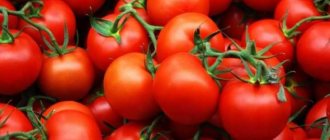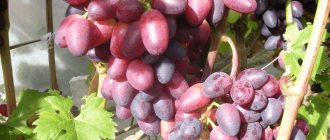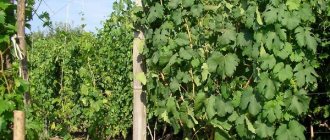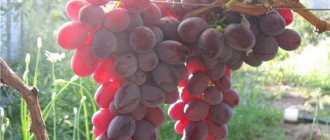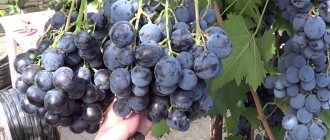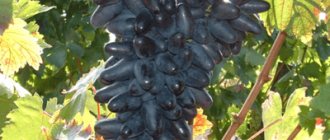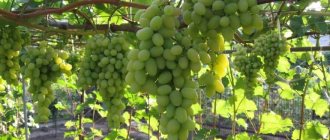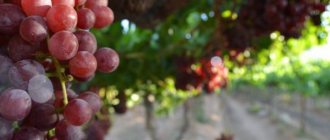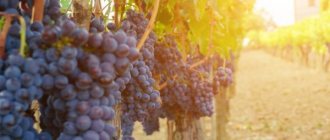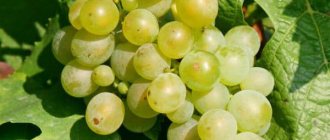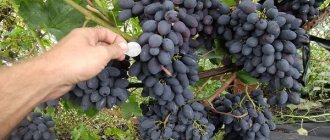Among grape varieties, gardeners give special preference to mid-late hybrids. They are valued for their convenient ripening period and quality characteristics obtained by crossing parental species. One of the popular and sought-after varieties is Fr.
Some winegrowers know it as the Moldovan hybrid “Consul”. Thanks to its excellent characteristics, the popularity of the variety is growing every year. To grow the famous Strashensky grapes on the plot, let’s turn to the description of the variety, as well as photos, reviews and videos of gardeners:
Breeding history
The “Strashensky” grape variety was bred in the 80s of the last century by the leading breeder of the Moldavian Research Institute of Viticulture, Zhuravel Mikhail Semenovich . A hybrid was obtained by crossing several parental forms: (Friendship x Katta-Kurgan x Dodrelyabi ) x Muscat de Saint-Valier .
It has a second name - “ Consul ”. Refers to table varieties. Among the table varieties, Karmakod, Korinka Russkaya and Alexander are also known.
“Strashensky” was created for cultivation in Moldova, the southern regions of Ukraine and Russia.
External parameters and characteristics of grapes
The description classifies the hybrid table variety Strashensky as a high-yielding species with an average ripening period. The bushes are formed powerful, with large leaf plates, the upper surface of which is smooth and the lower surface is covered with bristles. The advantage of the variety is resistance to frost and easy rooting of cuttings and seedlings.
At the moment of flowering, bisexual flowers are formed, so the plant does not need additional pollination. The large berries are round in shape and dark purple or almost black in color. The weight of one berry varies from 10 to 15 g, some grapes can reach 22 g.
Strashensky grapes: description of the variety
The bush is medium or vigorous. The height of the vine reaches 2 m . Each shoot is capable of bearing a harvest weighing 1.2 kg .
The clusters are large, weighing up to 1-1.5 kg each. The length of the grape cluster reaches half a meter. Anthony the Great, Helios and Vityaz can also boast of large clusters.
The berries are large ( from 8 to 14 g ), round, dark (almost black) in color. A bunch of medium looseness is formed.
Reviews
Arkady, Novorossiysk I purchased Strashensky grapes 5 years ago in the fall, without even knowing the characteristics. I really liked it for its appearance, article, beautiful noble clusters, curly leaves with a crimson color. I didn’t regret it at all. I advise everyone who takes up this variety for the first time to be patient. Sugar gains very slowly in the first years; most likely, it requires the formation of good perennial wood. Every year the acidity decreases, the taste becomes more and more pleasant.
Gennady, Stavropol Territory The variety is very productive, the clusters and berries are large. It does not like overload, otherwise the lower fruits may not ripen. I cut it short, pinch the shoot before flowering, shorten the bunch by one third - and no problems. I really like the taste, although many people think that it is simple. I do not recommend leaving it on the bush after ripening - this only worsens the taste.
Evgeniy, Krasnodar I am pleased with the Strashensky grape berries: the sweetness is not excessive, there is some sourness, they are crunchy. The fruits are large, fleshy, juicy. The bunches are usually stretched by 1.5 kg. Last year, only the berries were too small and the clusters were loose. Now there are many varieties that are superior to this one, but I am not going to give it up. This hybrid loves good care, you will have to work hard with it, but it will repay you doubly.
Photo
Photo of Strashensky grapes:
How to care for grapes (video)
The Strashensky grape is not just a very responsive variety to care. The description of the variety allows us to highly appreciate its quality characteristics. At the moment, it is very difficult to come across hybrid forms or varieties that have such returns as the Strashensky grapes. Of course, it is unlikely that an amateur gardener or a novice winegrower will be able to get good results in the first year of cultivating this variety. However, over time, there will be an excellent opportunity to obtain stable and high yields of berries with a harmonious taste from this highly commercial grape variety.
Characteristics
"Strashensky" refers to early and mid-early varieties ( 130-145 days ). Depending on weather conditions and the growing region, the crop ripens from late August to mid-September.
Early varieties also include Preobrazhenie, Yulian and Kishmish 342.
The shoots of the variety ripen well, up to 80%. The fruiting coefficient is 2.0 . The bush is capable of producing the first harvest in the 2nd year after planting.
The berries are thin-skinned, fleshy, and quite juicy. Sugar content accumulates in the region of 18 - 19% , acidity is in the range of 7-8 g/l .
The taste of the fruit is rated 8 points (out of 10 possible) on the grape tasting scale.
The yield of the variety is up to 250 c/ha in industrial cultivation and up to 30 kg per bush in private farming.
The drought resistance of the bushes is average. Also, the vines do not have good winter hardiness.
The average winter temperature should not fall below -17°C (in some cases they can withstand short-term frosts down to -24°C ). Also fond of warmth are Hadji Murat, Cardinal and Ruta.
Berries are not subject to long-term storage and long-term transportation. Grapes are consumed fresh, canned or pickled.
Advantages and disadvantages
To successfully grow grapes, you need to know the advantages and disadvantages of the chosen variety.
Pros:
- Resistance to spider mites, phylloxera, mildew.
- Pleasant taste.
- Large brush size.
- High yield.
- Easy to care for.
Minuses:
- High degree of oidium damage.
- Susceptibility to attacks by birds and wasps.
- The variety is unsuitable for long-term storage and long-distance transportation.
Diseases and pests
"Strashensky" is very rarely affected by phylloxera and spider mites. Resistance to mildew and rot is average ( 3 and 2 points, respectively).
Quite susceptible to oidimum.
The fight against common grape diseases, including anthracnose, bacteriosis, chlorosis and rubella, consists of timely preventive treatment of plants.
During the season, it is enough to carry out 3-4 sprayings: the first - in early spring, the rest - at regular intervals during the season (the last treatment should be carried out no less than a month before harvest).
Damage to berries by gray rot can be avoided if you harvest in a timely manner and do not allow the bunches to remain on the bush.
Strashensky berries accumulate sugar slowly, so the fruits are attacked by wasps and birds only in mid-August. To protect against insects and birds, winegrowers use special nets and mesh sleeves that cover bunches of grapes.
Useful properties and applications
The black Strasensky variety contains about 300 antioxidants , which neutralize free radicals, thereby strengthening the immune system and fighting malignant tumors. Resveratrol also performs the same function. Quertecin and flavonoids strengthen the walls of blood vessels, improve blood composition, destroy cholesterol plaques, and prevent the formation of blood clots. Pectin normalizes the functioning of the digestive system. A set of useful vitamins and minerals adjusts the functioning of the entire body in the right way, triggering all vital reactions.
Grapes are quite high in calories: 100 g of berries contain about 70 kcal. This should be remembered by those who are on low-calorie diets and are also prone to gaining excess weight.
“Strashensky” is suitable for fresh consumption; it can be used to make jam and preserves, or make homemade wine.
Features of cultivation
To obtain a high-quality grape harvest with beautiful, fully ripened fruits that have a balanced taste, you need to know some of the peculiarities of cultivating the variety.
Here are some of them:
- The "Strashensky" brush is very large, flowering along its entire length begins late, and accordingly, uneven ovary and fruit ripening occur.
When the berries at the top of the bunch are already ripening, at the bottom they can still remain green.This problem can be solved by pinching grape bunches by 1/3 of their length during the period of berry set. This will allow you to form a bunch of smaller volume, but with fruits of the same ripening period.
- During the period of mass ripening of berries, it is necessary to carry out selective cutting of ripened bunches. This will reduce the load on the bush and give strength to the vines to ripen the remaining harvest.
- Pruning Strashensky has some peculiarities - it is necessary to leave a sufficient number of stepsons to form good foliage of the bush (which directly affects the qualitative and quantitative characteristics of the crop).
- Depending on the latitude of cultivation, the different load of eyes on the bush is determined.
In Moldova, the region where the variety was created, a load of 40 to 60 buds per bush is allowed. In the Volga region, a good harvest can only be obtained if there are no more than 20 eyes on a bush.
Despite all the shortcomings of the variety, “Strashensky” has its fans and takes worthy places in many vineyards. Those winegrowers who prefer to grow exclusively unpretentious varieties usually choose Aleshenkin Dar, Muscat Delight or Giovanni.
Planting and care conditions
The quality of the purchased seedling is of no small importance, so it is necessary to purchase grapes only in specialized nurseries and preferably in the region in which the garden plot is located. The plant must be free of signs of damage and putrefactive defects.
Compliance with the necessary planting rules and providing the shoots with the conditions necessary for growth are the key to obtaining a decent harvest. Despite the fact that the variety is frost-resistant and can tolerate low temperatures in regions with cold climates, it is recommended to put it under shelter during the winter period.
To do this, the vines are removed from the supporting supports and placed under a protective structure until spring. This type of work is done before frost sets in. When forming a protective structure, it is important to take into account that the lack of air, humidity and excessive insulation will lead to the effect of “overheating” of the plant, which can negatively affect its condition in the spring or lead to death.
Pit depth and optimal placement of seedlings
Plantings are formed in spring or autumn; it is recommended to place them in even rows. A distance of 2.5 m must be maintained between shoots and 3 m between rows. A sufficient planting depth is considered to be 80 cm.
Before planting, you need to straighten the root shoots well, trim them and, if desired, soak them in a growth stimulator. At the time of planting, it is necessary to achieve uniform distribution of the roots inside the planting hole, then cover it with a layer of fertile soil and thoroughly water it.
The soil
Strashensky grapes are picky about the planting location and adequate lighting. It requires fertile soil and a lot of light, so for placement choose sunny southern areas, protected from gusts of wind. The plant does not tolerate stagnant water, so planting in areas close to groundwater should be avoided.
For light and sandy soils, it is not necessary to provide a drainage layer, since they allow moisture and oxygen to pass through well. Dense types of soil require intervention and adjustment of their qualities. Drainage made of crushed stone, crushed brick or coarse sand will help improve the quality of soil permeability and avoid stagnation of water.
Watering
The Strashensky variety is moisture-loving, so it requires regular, abundant watering. After planting the seedlings, the soil is moistened once every 7 days; after harvesting, the frequency is reduced to once a month. Excessive humidity may cause the grapes to crack.
Fertilizer
The nutritional value and fertility of the soil directly affect the fruiting rates of grapes. To improve the quality of the soil, fertilizers are applied. The first work is carried out in the fall, adding humus or compost when digging. When planning to plant seedlings in the fall, the fertilizer complex is applied to the holes 3 weeks in advance. When planting in spring, add 1 bucket of organic fertilizer and 1 g of superphosphate to one hole.
See also
Instructions for using the fungicide "Quadris" for processing grapes, waiting period and actionRead
Pruning and shaping the vines
Grapes of this variety are characterized by a long flowering period, which often negatively affects the ripening period of the fruit. To prevent such a problem, remove the first grape tassel on each bush.
Due to the fact that the variety is high-yielding, the shoots tend to suffer from overload.
To maintain proper plant health, it is necessary to cut off empty flowers and unformed buds. It is considered optimal for grapes to have no more than 18 eyes on one shoot. Pruning of grapes is carried out in a standard way. From 4 to 6 eyes are left on the shoot, taking into account that the largest clusters are formed at the second level.
Pollination
The hybrid produces flowers of both sexes, so the presence of female and male inflorescences allows only this variety to be planted on the site. For fruiting, Strashensky does not require planting other grape crops.
Flowering and fruiting period
The flowering and ripening of Strasensky grapes is delayed in time, which is due to the large size of the bunches. Often there is a situation where the top ones have already stopped blooming, and 1/3 of the bottom ones are just starting the process. A similar situation is observed during the period of fruit ripening.
The period of fruit production, depending on the growing region, ranges from 130 to 145 days. Their color change occurs gradually. The first signs of color acquisition are observed already in mid-July, which becomes more saturated by the end of the month. Ripening lasts for 2 weeks and the harvest can be harvested from the second week of August. The exact timing may vary slightly depending on the region and climatic conditions of cultivation.
Advantages and disadvantages of the variety
- The main advantages that made Strashensky grapes popular among gardeners:
- high productivity;
- increased commercial quality of bunches and berries;
- improved resistance to fungi and pests;
- the plant can withstand frosts down to –24°C and is also resistant to drought;
- The Strashensky crop is resistant to mechanical damage, which allows it to be transported over long distances.
- This grape is not without its drawbacks; these most often include:
- long flowering period;
- in cold climates the berry may not ripen completely;
- the variety is particularly susceptible to powdery mildew;
- fresh bunches cannot be stored for more than a few weeks.
Make drainage in the planting hole
Stage 1. Prepare planting material
| |
Stage 2. Find a place and dig a hole
| |
Stage 3. Prepare the nutritional mixture
| |
Stage 4. Plant the plant
| |
Stage 5. Water the seedling
|
Harvest and storage
The bunches are cut using pruning shears, and after harvesting they are placed in dry boxes. If you plan to preserve the berries longer, you need to remove all damaged, rotten fruits from the bunches. Then put them in small containers - up to 10 liters in volume. Lay out the products in 1 layer. Store in a cool, dry place.
Conditions for long-term storage:
- temperature 0…+4°С;
- humidity 90%.
Taking all the circumstances into account, it is not surprising that Pharaoh is one of the varieties with great prospects. In a short time, without being fully explored, it has already gained a lot of admirers among winegrowers. Undoubtedly, its popularity will only increase in the future.
